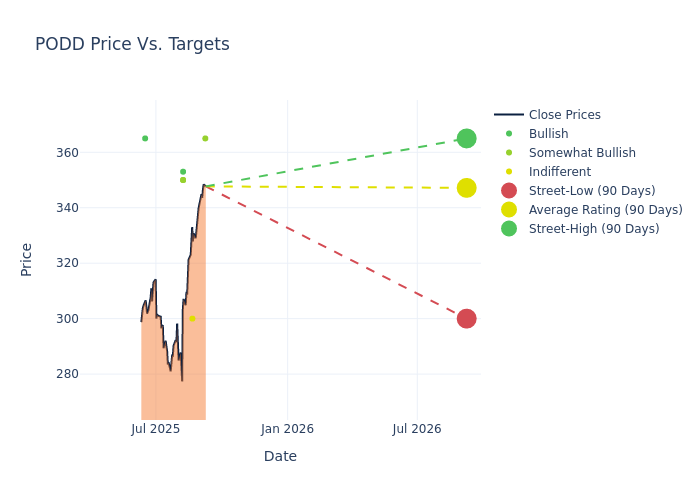Assessing Insulet: Insights From 6 Financial Analysts
Author: Benzinga Insights | September 08, 2025 03:01pm
Throughout the last three months, 6 analysts have evaluated Insulet (NASDAQ:PODD), offering a diverse set of opinions from bullish to bearish.
The following table summarizes their recent ratings, shedding light on the changing sentiments within the past 30 days and comparing them to the preceding months.
|
Bullish |
Somewhat Bullish |
Indifferent |
Somewhat Bearish |
Bearish |
| Total Ratings |
2 |
3 |
1 |
0 |
0 |
| Last 30D |
0 |
1 |
0 |
0 |
0 |
| 1M Ago |
0 |
0 |
1 |
0 |
0 |
| 2M Ago |
1 |
2 |
0 |
0 |
0 |
| 3M Ago |
1 |
0 |
0 |
0 |
0 |
Analysts have recently evaluated Insulet and provided 12-month price targets. The average target is $347.17, accompanied by a high estimate of $365.00 and a low estimate of $300.00. This upward trend is apparent, with the current average reflecting a 9.79% increase from the previous average price target of $316.20.

Decoding Analyst Ratings: A Detailed Look
The standing of Insulet among financial experts is revealed through an in-depth exploration of recent analyst actions. The summary below outlines key analysts, their recent evaluations, and adjustments to ratings and price targets.
| Analyst |
Analyst Firm |
Action Taken |
Rating |
Current Price Target |
Prior Price Target |
| Steven Lichtman |
Oppenheimer |
Raises |
Outperform |
$365.00 |
$324.00 |
| Matt Miksic |
Barclays |
Raises |
Equal-Weight |
$300.00 |
$266.00 |
| William Plovanic |
Canaccord Genuity |
Raises |
Buy |
$353.00 |
$331.00 |
| Shagun Singh |
RBC Capital |
Raises |
Outperform |
$350.00 |
$330.00 |
| Lawrence Biegelsen |
Wells Fargo |
Raises |
Overweight |
$350.00 |
$330.00 |
| Richard Newitter |
Truist Securities |
Announces |
Buy |
$365.00 |
- |
Key Insights:
- Action Taken: Analysts respond to changes in market conditions and company performance, frequently updating their recommendations. Whether they 'Maintain', 'Raise' or 'Lower' their stance, it reflects their reaction to recent developments related to Insulet. This information offers a snapshot of how analysts perceive the current state of the company.
- Rating: Analysts unravel qualitative evaluations for stocks, ranging from 'Outperform' to 'Underperform'. These ratings offer insights into expectations for the relative performance of Insulet compared to the broader market.
- Price Targets: Analysts provide insights into price targets, offering estimates for the future value of Insulet's stock. This comparison reveals trends in analysts' expectations over time.
Capture valuable insights into Insulet's market standing by understanding these analyst evaluations alongside pertinent financial indicators. Stay informed and make strategic decisions with our Ratings Table.
Stay up to date on Insulet analyst ratings.
Get to Know Insulet Better
Insulet was founded in 2000 with the goal of making continuous subcutaneous insulin infusion therapy for diabetes easier to use. The result was the Omnipod system, which consists of a small disposable insulin infusion device that can be operated through a smartphone to control dosage. Since the Omnipod was approved by the US Food and Drug Administration in 2005, approximately 500,000 insulin-dependent diabetic patients are using it worldwide.
Insulet's Financial Performance
Market Capitalization Analysis: The company's market capitalization is below the industry average, suggesting that it is relatively smaller compared to peers. This could be due to various factors, including perceived growth potential or operational scale.
Revenue Growth: Insulet displayed positive results in 3M. As of 30 June, 2025, the company achieved a solid revenue growth rate of approximately 32.88%. This indicates a notable increase in the company's top-line earnings. When compared to others in the Health Care sector, the company excelled with a growth rate higher than the average among peers.
Net Margin: Insulet's net margin lags behind industry averages, suggesting challenges in maintaining strong profitability. With a net margin of 3.47%, the company may face hurdles in effective cost management.
Return on Equity (ROE): Insulet's ROE lags behind industry averages, suggesting challenges in maximizing returns on equity capital. With an ROE of 1.61%, the company may face hurdles in achieving optimal financial performance.
Return on Assets (ROA): The company's ROA is below industry benchmarks, signaling potential difficulties in efficiently utilizing assets. With an ROA of 0.64%, the company may need to address challenges in generating satisfactory returns from its assets.
Debt Management: The company faces challenges in debt management with a debt-to-equity ratio higher than the industry average. With a ratio of 0.96, caution is advised due to increased financial risk.
The Basics of Analyst Ratings
Benzinga tracks 150 analyst firms and reports on their stock expectations. Analysts typically arrive at their conclusions by predicting how much money a company will make in the future, usually the upcoming five years, and how risky or predictable that company's revenue streams are.
Analysts attend company conference calls and meetings, research company financial statements, and communicate with insiders to publish their ratings on stocks. Analysts typically rate each stock once per quarter or whenever the company has a major update.
Some analysts publish their predictions for metrics such as growth estimates, earnings, and revenue to provide additional guidance with their ratings. When using analyst ratings, it is important to keep in mind that stock and sector analysts are also human and are only offering their opinions to investors.
Which Stocks Are Analysts Recommending Now?
Benzinga Edge gives you instant access to all major analyst upgrades, downgrades, and price targets. Sort by accuracy, upside potential, and more. Click here to stay ahead of the market.
This article was generated by Benzinga's automated content engine and reviewed by an editor.
Posted In: PODD





